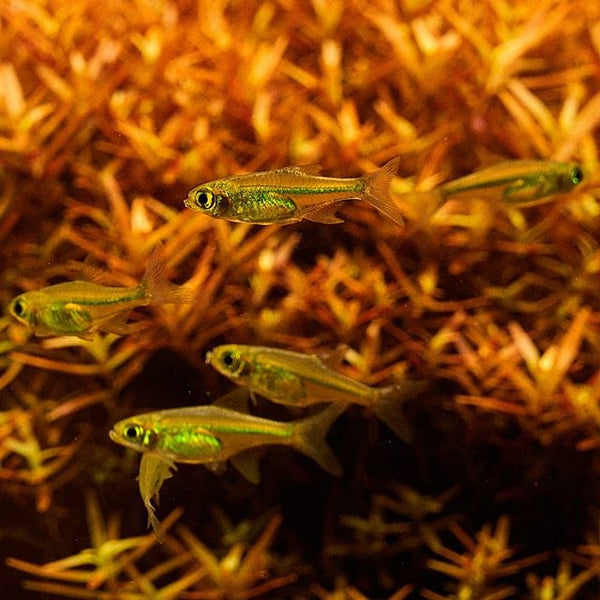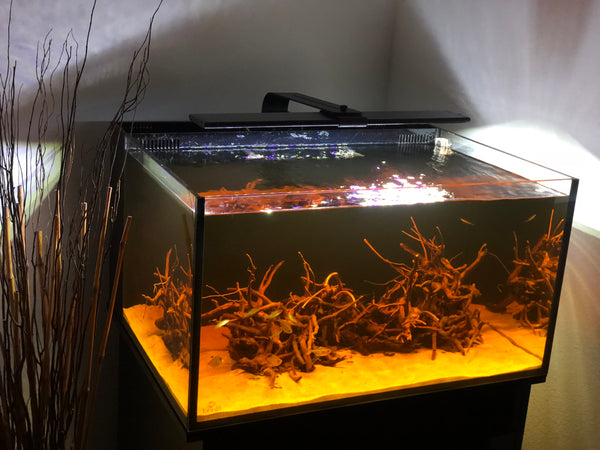- Continue Shopping
- Your Cart is Empty
Brown and Brown and...brown. Approaches, techniques...and the implications of shortcuts...
We sure exist in a funny world, huh?
One of the things I read about from time to time in various hobby social media discussions is the dislike many people have for the tint that wood and such impart into the water.
In fact, some of the posts we see on social media or aquascaping/plant forums are literally pleas for help...stuff like, "When will this brown tint go away?"
I see that kind of stuff and- jerk that I am- kind of laugh.
And that is pretty mean of me, I know.
Sure, I get it. Not everyone appreciates, likes, or even has the remotest interest in the earthy brown water that we obsess over around these parts! Yet, it was these unfortunate souls who made me realize the fastest, easiest way to "jump start" the tinted look in your tanks is to simply put partially cured driftwood in them!
Of course, there is the strange dichotomy that exists:
In stark contrast to the desperate calls for suggestions of hapless planted tank enthusiasts about when their damn piece of driftwood will stop leaching, I'll literally get emails and pm's from hobbyists who are upset because they can't get their tanks "dark" enough.
That's how far we've come, lol. I'm pretty convinced that we as a hobby are weird.
And that's okay.
Now, a lot of you have asked about the use of commercial "blackwater extracts" and Rooibos tea for these purposes, and if we plan on carrying them.
Short answer: We don't. We won't.
Why?
It's NOT because these are not "cool" or because they "accomplish the same things as the leaves we sell" or whatever...
It's because I feel that they are "shortcuts" which hobbyists tend to use in place of a "system", "approach", or methodology to accomplish the same thing on a continuous basis. As you know, I tend to look at "hacks" or whatever you call them, when used in place of other procedures, as a "band aid" of sorts- used to quickly provide a desired result, without a long-term approach to managing your aquarium ("C'mon, Scott, you just brew another cup of tea...").

Now, as a long-time reef aquarist, I'll tell you that there absolutely is a value to use of appropriate additives and such which, when used in conjunction with an integrated approach, can consistent, give long-term results. And sure, we may offer products which are intended to integrate with our approach and help facilitate results..key word here being "integrate"- not "substitute." You can't just add a "drop of this" or a "pinch of that" to create optimum environmental conditions for your fishes and call it a day.

It's different than say, using an RO/DI unit to pre-treat your tap water obtain optimum "base water" conditions from which you can modify them with natural materials and such. That's an example of a vehicle to help us create the environment we seek on a consistent basis...not a "shortcut" or fix that overlooks the big picture.
That being said, I think that our entire botanical-style aquarium approach needs to be viewed as just that- an approach. A way to use a set of materials, techniques, and concepts to achieve desired results consistently over time. A way that tends to eschew short-term "fixes" in favor of long-term technique. In my opinion, this type of "short-term, instant-result" mindset has made the reef aquarium hobby of late more about adding that extra piece of gear or specialized chemical additive as means to get some quick, short term result than it is a way of taking an approach that embraces learning about the entire ecosystem we are trying to recreate in our tanks and facilitating long-term success.
Yeah, once again- the "problem" with Rooibos or blackwater extracts as I see it is that they encourage a "Hey, my water is getting more clear, time to add another tea bag or a teaspoon of extract..." mindset, instead of fostering a mindset that looks at what the best way to achieve and maintain the desired results naturally on a continuous basis is. A sort of symbolic manifestation of encouraging a short-term fix to a long-term concern.

Again, there is no "right or wrong" in this context- it's just that we need to ask ourselves why we are utilizing these products, and to ask ourselves how they fit into the "big picture" of what we're trying to accomplish. And we shouldn't fool ourselves into believing that you simply add a drop of something- or even throw in some Alder Cones or Catappa leaves- and that will solve all of our problems. Are we fixated on aesthetics, or are we considering the long-term impacts on our closed system environments.
Sure, I can feel cynicism towards my mindset here. I understand that.
However, if we look at the use of extracts and additives, and additional botanicals- for that matter- as part of a holistic approach to achieving continuous and consistent results in our aquariums, that's a different story altogether.
It makes a lot more sense to learn a bit more about how natural materials influence the wild blackwater habitats of the world, and to understand that they are being replenished on a more or less continuous basis, then considering how best to replicate this in our aquariums consistently and safely.

Again, lest you think I'm simply taking this mindset to "sell more of my stuff" instead of seeing hobbyists buy teabags or tonics, let me set you straight one more time: Remember, botanical materials not only add tannins, humic substances, and other valuable organic compounds- they create a "structural" part of the habitat. A place for fishes to hide, spawn, forage. And they encourage the growth of beneficial biofilms, fungal growths, and crustaceans- just like they do in nature. And yeah, they look interesting, too. That whole "functional aesthetic" idea again.

I don't think that a tea bag or an "elixir" can do that on its own.
Stay curious. Stay attentive. Stay open-minded. Stay considerate...
And Stay Wet.
Scott Fellman
Tannin Aquatics







Scott Fellman
Author